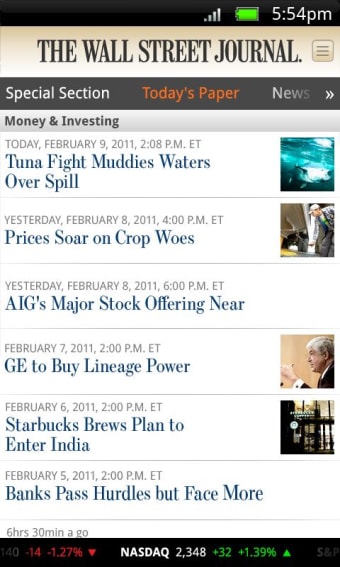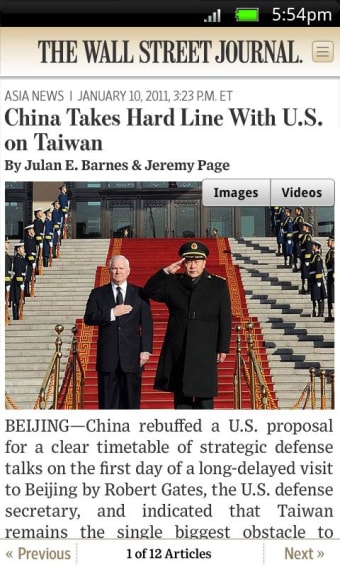
The Wall Street Journal: Business & Market News
safenonpoisonousdetected
- type:Browsers
- Version:v5.17.2.3
- size:0MB
- update time:2024-04-29 08:10:44
tag:
Hot collection
List recommendation
- introduction
- picture
- Boutique
- Related
Editors' ReviewDownload.com staffNovember 10, 2018The Wall Street Journal is one of the biggest and most respected news organizations in the United States, with 30 Pulitzers under its belt since the esteemed prizes for journalism began a century ago. The Journal was also among the pioneers of digital newspaper subscriptions, which for the New York City-based newspaper hit 1.4 million as of December 2017. However, the Journal also has one of the most expensive subscription prices among newspaper apps. Does it earn its premium compared to the more economical New York Times or Washington Post?ProsA clean and inviting look: Headline and intro texts are quite legible, and Android gets an optional dark theme for less eye strain at night. You can cycle through several text sizes by tapping on the "Aa" icon on an article page. Every story can be shared and saved from within the newsfeed, without having to open the individual article first.Good controls to avoid spam: The in-app notification settings are readily available in the lower right-hand corner of the screen, so you can quickly and easily toggle them on and off. Of the nine available notifications, only Breaking News is enabled by default, which we find sensible and fair. The Android version of this section of the app also has a History tab where you can review all the notifications that it's sent, in case you believe that you've missed some. Meanwhile, we counted nearly 60 different email newsletters on tap, with none of them set to be sent by default. Every news category they cover appears to be represented, plus collections of deals, a newsletter specifically about wine, career advice, a digital copy of the day's physical newspaper, and "Brexit & Beyond." And almost all of these can be previewed with one tap, so you don't have to commit to see what you're getting.Good background data download tools on Android: By default, the Journal app downloads only text in the background, on Wi-Fi, every two hours (with notifications operating on their own schedule). You can toggle it to use an LTE connection and to download images as well as text, and you can slow down the background update to "Overnight" or disable it altogether. This section is located right off the "hamburger" menu in the upper left, making it another popular function that the app manages to make accessible despite the limited screen space that a mobile app has to work with.Unfortunately, these settings are not available in the iOS version of the app.Optimized for investors, but still solid for general news coverage: Nearly every story that appears in the Journal feels like it's written for an audience with a large investment portfolio, but this isn't necessarily a bad thing. As the name of the paper states, it's a journal for Wall Street, so almost all of its coverage is written for people who want to know if they should buy, sell, or hold investments that are impacted by a given story.ConsRelatively expensive for most customers: The regular price of an "All Access Digital" subscription is $37 a month, and we were not able to dig up any other digital-only subs. Even with the current discount of 50 percent off for up to 12 months, the Journal remains notably more expensive than the Washington Post or the New York Times. If you're an Amazon Prime subscriber, you can get a generous six-month free trial of the Post, followed by a fee of just $4 a month. (Amazon's CEO Jeff Bezos bought the Post in 2013.) The Times can be had for $10 a month right now, which over the course of one year is actually less than its cheapest annual payment option.Since the Journal wants at least $18.50 a month, and it displays ads even to paying subscribers, the combination is a tough sell unless you need its market insight. However, students can subscribe to the Journal right now for only $49 a year, with a 15-week trial for $1, making it roughly as cheap as the Post is for Amazon Prime users.Subscribers will still see ads in the app: While certain news organizations offer to remove ads from their site or app in exchange for a subscription, the Journal is not one of them. To be fair, the NY Times app also displays ads to subscribers, and the Washington Post periodically inserts branded content into its app's feed. The latter format is technically still an ad, but it does at least blend in better. Since the Times and Post both cost much less than the Journal, their inclusion of ads is more palatable.User experience will vary according to your platform: There's a ribbon of icons on the bottom of the screen that provides shortcuts to certain functions, but the set of functions differs between iOS and Android. In iOS 11.3 on an iPhone 8+, we get five icons at the bottom. From left to right: News, MyWSJ, Market Data, Notifications, and Profile. But on a Motorola Moto X4 running Android 8.0, we get Latest News, Today's Paper, Saved, and Notifications.The iOS version also has a stock ticker running along the top of the screen, while the Android version has a list of news categories there instead. In fact, we were unable to locate a stock ticker feature or market data tracker anywhere in the Android version. Section navigation is arguably better on iOS as well; tapping the Sections button gives you a vertical list that fills up the whole screen, while Android tries to stuff it into a narrow horizontal ribbon that you can swipe left and right. The latter approach feels slick, but it definitely takes more time to go through the section list this way.However, the Android version was much better at retrieving recent articles, which is important when one of the things you're paying a premium for is breaking news. In section after section on iOS, we repeatedly encountered yesterday's news -- literally. The only fix we found was to use the iOS app's Reset Content function, which forces it to re-download all available articles. Considering how pricey the Journal is, having to manually reset and restart the app to receive the latest content is disappointing.Obviously, some of these differences are due to the design guidelines established by Google and Apple, but the interface and content presentation diverge more than we're used to, in ways that often feel arbitrary.Bottom LineGiven the combination of a high price tag and in-app ads, plus a few technical and design issues, it's hard to recommend the Wall Street Journal app over those for the New York Times or the Washington Post.
Screenshot group
Boutique recommendation
Related recommendation
Ranking in this category
more type
- Game information
- Walkthrough
- Exclusive to girls
- Exclusive for boys
- Mobile game assistance
- Legendary game
- Xianxia game
- Business development
- physical exercise
- Card game
- Racing car racing
- Take risks to solve puzzles
- Break through the barrier
- Leisure puzzle
- Strategic tower defense
- Shooting gun battle
- Cosplay
- Utilities & Tools
- Travel
- Security Software
- Screensavers & Wallpaper
- Productivity Software
- Multimedia
- Internet Software
- Games
- Entertainment Software
- Educational Software
- Developer Tools
- Communications
- Browsers




















![e [eNanyang] - Malaysia Latest News](https://image.7miao.net/downloads/uploads/thumb/0419/18010434_2024eigzwcpzcrf19)



